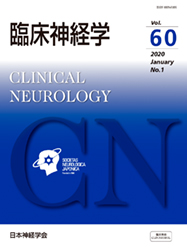Volume 60, Issue 10
Displaying 1-15 of 15 articles from this issue
- |<
- <
- 1
- >
- >|
-
2020 Volume 60 Issue 10 Pages 643-652
Published: 2020
Released on J-STAGE: October 24, 2020
Advance online publication: August 20, 2020Download PDF (3454K) Full view HTML
Review
-
2020 Volume 60 Issue 10 Pages 653-662
Published: 2020
Released on J-STAGE: October 24, 2020
Advance online publication: September 05, 2020Download PDF (8106K) Full view HTML -
2020 Volume 60 Issue 10 Pages 663-667
Published: 2020
Released on J-STAGE: October 24, 2020
Advance online publication: September 05, 2020Download PDF (435K) Full view HTML -
2020 Volume 60 Issue 10 Pages 668-676
Published: 2020
Released on J-STAGE: October 24, 2020
Advance online publication: September 05, 2020Download PDF (1963K) Full view HTML
Case Reports
-
2020 Volume 60 Issue 10 Pages 677-681
Published: 2020
Released on J-STAGE: October 24, 2020
Advance online publication: September 05, 2020Download PDF (4679K) Full view HTML -
2020 Volume 60 Issue 10 Pages 682-687
Published: 2020
Released on J-STAGE: October 24, 2020
Advance online publication: September 05, 2020Download PDF (1855K) Full view HTML -
2020 Volume 60 Issue 10 Pages 688-692
Published: 2020
Released on J-STAGE: October 24, 2020
Advance online publication: September 05, 2020Download PDF (2028K) Full view HTML -
2020 Volume 60 Issue 10 Pages 693-698
Published: 2020
Released on J-STAGE: October 24, 2020
Advance online publication: September 05, 2020Download PDF (1922K) Full view HTML -
2020 Volume 60 Issue 10 Pages 699-705
Published: 2020
Released on J-STAGE: October 24, 2020
Advance online publication: September 05, 2020Download PDF (2318K) Full view HTML -
2020 Volume 60 Issue 10 Pages 706-711
Published: 2020
Released on J-STAGE: October 24, 2020
Advance online publication: September 05, 2020Download PDF (5392K) Full view HTML
Brief Clinical Notes
-
2020 Volume 60 Issue 10 Pages 712-715
Published: 2020
Released on J-STAGE: October 24, 2020
Advance online publication: September 05, 2020Download PDF (2010K) Full view HTML
Proceedings of the Regional Meeting
-
2020 Volume 60 Issue 10 Pages 716-724
Published: 2020
Released on J-STAGE: October 24, 2020
Download PDF (1583K)
Notice
-
2020 Volume 60 Issue 10 Pages 725-731
Published: 2020
Released on J-STAGE: October 24, 2020
Download PDF (405K)
Editor’s Note
-
2020 Volume 60 Issue 10 Pages 732
Published: 2020
Released on J-STAGE: October 24, 2020
Download PDF (161K)
Erratum
-
2020 Volume 60 Issue 10 Pages 733
Published: 2020
Released on J-STAGE: October 24, 2020
Download PDF (56K)
- |<
- <
- 1
- >
- >|
